Text
☀️Deities☀️
I see so many people criticizing others over their relationships, or lack thereof, with their deities, so here are some reminders:
Not having deities is okay.
Having just a devotional relationship with your deities is okay.
Having a working relationship with your deities is okay.
Playing games with your deities is okay.
Harmless jokes with your deities are okay.
Doing fun things with your deities is okay.
Doing devotional offerings for your deities is okay.
Giving physical offerings to your deities is okay.
Not being able to do certain offerings for deities is okay.
Having an altar for your deities is okay, no matter the size.
Not having an altar for your deities is okay.
Laughing with your deities is okay.
Crying with your deities is okay.
Having genuine conversations with your deities is okay.
Being unable to hear/see deities is okay.
Being able to hear/see deities is okay.
Not being able to communicate through divination is okay.
Using divination as a key element in communication is okay.
Not calling on deities during spellwork is okay.
Asking deities to help during spellwork is okay.
Asking deities for help in general is okay.
This is your relationship with your deities in your practice. Don't let anyone tell you what you can and can't do. 🫶
It's 2am, please forgive me if there are any mistakes!
1K notes
·
View notes
Photo
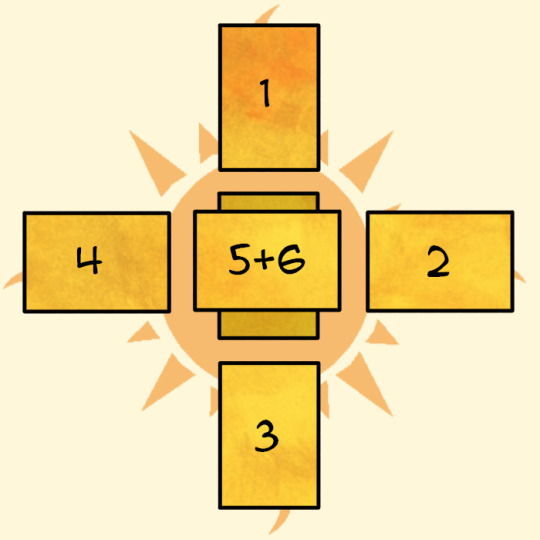
“I’ve got some irons in the fire” Spread
Currently facing a period of change and are unsure about how you got there and what the future holds? This spread could be just what you’re after!
1 : What led to this situation?
2 : What can affect the outcome of this situation?
3 : How are you currently dealing with the situation?
4 : What is the worst case scenario?
5 + 6 : What is the best case scenario? (These cards are to be read together).
2K notes
·
View notes
Text
From Notes to Grimoire
I’ve talked some about my thoughts and recommendations for taking notes for witchcraft, but what comes after that? In my method, notes are taken in a date-based, linear fashion. Subjects aren’t usually grouped together (unless you’re using separate notebooks for specific topics), and it can be tough to use rough notes like that for much more than basic study. I said in that post that I wasn’t talking about a reference document; I was just talking about writing down thoughts, ideas, spell tests, book notes, study notes, theory notes, and other assorted things as you research and learn about your craft.
So what about when you want to take your rough study notes and turn them into a nice-looking, well-organized, practical collection that’s better for regular referencing and actual use? That’s when you go from notes to grimoire.
(Note that this post is loaded with my opinions. I say it throughout, but go into this knowing that I’m speaking from my personal perspective — you won’t, and really you shouldn’t — agree with everything I say here.)
What Goes into a Grimoire?
Ultimately, what you put in your grimoire is up to you. I’m of the opinion that grimoires are and should be working documents. If you aren’t familiar with the term “working document,” it just means that the contents of the grimoire are always under construction. It means that you’re allowed to add, remove, and modify things as your practice changes over time. It also means that you’re supposed to reevaluate the grimoire’s contents every so often to make those updates. Complacency is the enemy of progress — there’s always a new question to ask or a new perspective to take. Keep the working document mentality in mind while you decide what to put in your grimoire.
With that said, in my opinion, a grimoire is not a place to take raw notes, write out theories, test spells, or even record divinations. Those things ought to go in your notebook, not your grimoire.
A grimoire is a reference document. It holds information on the spells, rituals, traditions, incantations, observances, and materials you actually use and need to look up. Grimoires are practical tools. Yes, they can look nice, but if the function isn’t there, it isn’t a grimoire — it’s just a scrapbook.
So, what should you put in a grimoire? Here’s a general idea of things I’d recommend:
Proven spells and recipes
Rituals you perform and when you perform them
Sigils, symbols, and spell vessels you’ve made and what they’re for
Instructions for making or obtaining materials for spellwork
A reference sheet for making substitutions
Holidays and events you observe and how you observe them
Divination instructions, including cartomancy spreads, magpie oracle charm lists, symbols you look for, and other relevant information
Plant, herb, stone, and crystal profiles
Fire, smoke, pet, and other safety details and instructions
Your astrological chart and its meanings
Profiles on spirits and deities you work with, including preferred offerings, important dates, descriptions of vessels, and details about any ongoing deals or agreements
Anything you commonly need to reference from books, online articles, or other sources
Conversely, here are things that should not go in a grimoire:
Notes on books you’re reading
Spells that are works in progress
Drawings of sigils in progress
Divination notes
Lists of books you want to read
Lists of topics you want to research next
Notes on spirit encounters
Journal pages
Rambles on magic theory
Information that has nothing to do with your witchcraft, spiritual path, religion, or other related field
Information you simply will not use
Obviously, you can add and remove things as you see fit. You should put whatever you commonly reference and whatever is practical for you in your grimoire. If you’re using it all the time, put it in there. If you don’t use something that “everyone” says “has” to be in your grimoire, don’t put it in. For example, I don’t use my astrological chart for anything. I know my big three, and that’s good enough for me. So, it doesn’t go in the book, no matter how many times I see it on those “what to put in your grimoire!” lists that go around witchblr every so often. Similarly, if you don’t have pets, you don’t need to put pet safety information in your book.
Use your common sense and discretion. Your grimoire is yours. If it isn’t practical, don’t put it in. If it is practical and relevant to you, but no one “recommends” putting that particular bit of information down in a grimoire, who cares? Write it down. You can always take it out later.
Creating and Maintaining a Working Document
Now, you’ll see grimoires referred to as working documents (or “living” documents) pretty frequently. You’re allowed to (and meant to) change things over time as you and your practice change.
But how do you do that? How do you keep an organized, practical reference document if it’s constantly changing?
Well, first of all, stop over-thinking it (I say to myself, frequently and loudly). Second of all, no matter what format you choose, from bound notebooks to binders to apps, the primary idea is to evaluate the contents regularly and to keep them in some kind of predetermined order. How that will look and how frequently you do reviews depends on you, your preferences, your practice, and the medium you choose. So, let’s have a look at some options and how I would suggest setting them up as a working-document-grimoire.
Binders
First (and best, in my opinion), are binders. There are a plethora of sizes and styles, so you can choose based on portability, available volume, color, and features according to your needs.
By far, the greatest benefits of using a binder for a grimoire are versatility and adaptability. You can create sections by inserting hunks of cardboard, sheets of colored paper, or pre-made pages with tabs that stick out for easy navigation. And, if you decide you don’t like the way your sections are organized, you can easily open the binder rings, take the section out, and put it wherever you want. In the same way, you can add and remove pages to any section at any point. You don’t have to allot space ahead of time or worry about running out of room in a given section.
Binders have a sort of inherent working document nature. With these, I would recommend reading through the entire thing at least twice a year to review the contents. When something sticks out as inaccurate, unused, or outdated, remove it. You can discard the page entirely or set up a separate “archive” folder to keep it in so you can look back and remember what you’ve taken out. (I keep one of these, though I’m considering moving it into a folder clipped into the back of my grimoire binder.)
On the other hand, if you find something in your grimoire that needs more attention, detail, or elaboration — or you just get inspired and want to add a new spell or bit of information to what’s already there — you can pull out the old page and replace it, or you can add a new page right after the existing one.
It’s up to you how frequently you go through your grimoire. Remember that this is a practical reference document. Set it up in a way that makes sense to you. Again, the nice thing about binders is that if you decide the way you’ve set it up is no good, you can change it without having to start over completely.
Notebooks
Obviously, there are a ton of types of notebooks out there. It comes down to pure personal preference what kind you go with.
Because notebooks can’t be rearranged in the same way that a binder can, keeping one as a working document obviously looks different. With any kind of bound notebook, I recommend doing a sort of yearly review. If much of your practice has changed, or if you find you’ve run out of room in your grimoire for new entries, it’s time to start into a new notebook. This doesn’t mean you have to disregard the original grimoire entirely.
You can copy over spells, information, and whatever else you like into the new book and shelf the original as a relic or treat the books like volumes in a series. In that way, you wouldn’t copy more than the essentials into the new grimoire; you would instead add entirely new spells, rituals, and information to it.
Either way, I would suggest dating the books. I would jot down at least the year(s) you work in the grimoire for organizational purposes. Remember that practicality and usability are the names of the game. You want to be able to use these books as references for your magical practice to help you remember things accurately.
The major drawback of any kind of notebook is that if you find you hate the way you’ve set it up, you can’t just go back and rearrange it. Once it’s down on paper, it’s down. You would either have to rip out the pages and move them manually, leaving them loose or re-pasted into their new places, or start up a new notebook entirely.
On the other hand, that has benefits, too. It removes the temptation to arrange and rearrange endlessly. If you’re indecisive and would waste too much time worrying about layout as opposed to getting a functional document up and running (even if it’s imperfect), a notebook may actually be a pretty good choice for you. It’s an exercise in tolerance for imperfection, to say the least.
Now, let’s have a brief look at different kinds of notebooks.
Divided Notebooks
First, let’s look at notebooks that come divided already. Whether it’s a subject-divided spiral notebook, a journal with built-in title pages, or journals that are divided into smaller journals inside them, part of the work has already been done for you.
A drawback of using these types of notebooks or journals is that you lose the ability to decide how much space is given to a particular subject. On the other hand, it can make getting started much, much easier. My first grimoire was in a large spiral-bound five-subject notebook. I divided it into five sections: Spells, Holidays and Seasons, Spirits, Plants, and Miscellaneous. Granted, at the time, I was taking notes into my grimoire. It wasn’t a very practical document; that wouldn’t come until several years later, when I figured out why I couldn’t remember anything with any sort of reliability. Now, I’ve got very strong opinions on note-taking and record-keeping.
It’s the chemistry nerd in me.
Blank Notebooks
This includes plain lined notebooks, unlined notebooks, and bullet journals. These are harder to use, in my opinion. I don’t think they’re very friendly to beginners who are creating their very first grimoire. These lend themselves better to note-taking notebooks than official grimoires, but you can certainly make them work.
To make a blank notebook function as a grimoire, you should spend a bit of time deciding the order of contents. How many pages do you want to dedicate to a given subject? What subjects will you place next to each other? Will information about moon phases be followed by planetary information, or will you talk about moon water and moon-based spellwork? Do you want to create sections and title pages ahead of time?
To make it organized, you’ll want to decide these things somewhat in advance or leave room to add them later on. It’s easier to add (taping, gluing, paper-clipping, etc.) or remove (cutting, tearing, etc.) pages in some notebooks than others. Take that into account when you choose a notebook for your grimoire!
Sketchbooks
For the more artistically inclined magical practitioner, a sketchbook might make a good choice. If you plan on using materials like paint or watercolors, the thicker paper stock would be a solid asset. Artists will feel right at home drawing sketches, diagrams, sigils, and other illustrative details in their grimoires with a sketchbook. They have the same drawbacks as blank notebooks, being complete blank slates that you have to plan around, but they do end up being very nice to look at.
Like with blank notebooks, consider the order you want to put things in. Jot down titles, content, and ideas for drawings or art pieces you’d like to include in the final product. Remember that because the book is bound, you may not be able to add things to sections that have already been filled in. Consider artistic ways to show what’s on a given page to make it easier to manage — color-coded page edges, for example, might be an idea.
Junk Journals
I genuinely wouldn’t recommend using a junk journal for a formal grimoire. By their nature, they’re messy, disorganized, and difficult to parse through for information. They’re fun to make, don’t get me wrong — I love a junk journal for regular journaling and inspiration. But they don’t lend themselves toward organizational systems. If you’re going to use a junk journal as your formal grimoire, you’ll either have to resign yourself to hunting through pages for what you’re looking for or do some extensive planning in advance.
The best way to make a practical, working-document-style junk journal would be to combine it with a binder, I think. Create those iconic, aesthetic pages. Punch holes in them and place them into a binder in the correct location. That way, you still get the pretty aesthetic of the junk with the practicality of what a grimoire should actually be.
(Personally, I would use the junk journal aesthetic for section title pages in a binder — give it some personality and decoration without sacrificing any of the practicality.)
Digital Documents
I say that binders are the best option, but honestly, digital grimoires are up there, too. If you need to keep your magical practice more secret, if you don’t have time or energy to put together a physical book, or if you would prefer to have a system you can reorganize at the drop of a hat, digital grimoires might be right for you.
There are a ton of programs out there you can use. I’ve used Word, Scrivener, and Obsidian for grimoires and/or witchcraft note-taking, personally. Of them all, Obsidian is the one I would recommend most strongly. Word is… well, it’s Word. Scrivener is wonderful as a writer’s tool, and I use it to write these posts! I had moderate success with it for grimoire work. By far, Obsidian has been the best. The back-linking capabilities alone revolutionized the way I set up my grimoire (and other reference documents, including TTRPG notes). I really can’t recommend it enough.
Another program I’ve seen recommended frequently is Notion. While I can’t speak about it myself, since I haven’t used it, it does get rave reviews — particularly from folks who like to have a nicer aesthetic for their craft. Obsidian is pretty bare-bones aesthetic-wise, so if that’s important to you, Notion may be an option to consider.
With digital grimoires as working documents, I would follow the same guidelines as with a binder. Review the contents regularly, archive anything outdated, and evaluate the organizational layout for practicality. My biggest suggestion is to date the individual entries. Include the date you first create the page, obviously, but I would also include the date of the most recent update. If you want to get really lab-notebooky and formal about it, you could include every date you update it. (That’s what I do, personally, but I come from a database management background.)
The main downside to a digital grimoire is accessibility. If you’re out in the middle of nowhere without a computer or cell service, you may not be able to access your grimoire. I’ve seen folks set up entire grimoires using the notes app on their phones to make it easy to carry around, which is fine… unless you find it difficult to type with a phone keyboard. Physical books can be transported via bags, and they don’t need to be charged like a phone or laptop.
I also find that digital grimoires often lack the charm of a physical one. Even pretty, aesthetic templates on Notion are missing that witchy feeling. You know the one I mean — cracking open a tome of secrets to access the magic within just can’t be done through a screen.
Turning Notes into Reference Materials
This is probably the toughest part. After you decide what you want to include in your grimoire, now you’ve got to actually go through your notes and put together your collection.
The tone of your grimoire doesn’t necessarily need to be overly formal. It also doesn’t have to be publisher-ready. You aren’t writing a book on magic. You’re putting together a collection of materials that you want to be able to reference quickly and easily. It doesn’t have to make sense to anyone else or be absolutely perfect. Remember — this is a working reference document for you. If you mess it up, you can fix it later. Don’t be afraid to cross stuff out or be a little messy. So long as it stays practical and reference-able, you’re fine.
Spells and rituals are probably the easiest things to copy into a grimoire. You might even be able to copy them over verbatim from your notes, depending on how you took the notes. Bring over any changes you made to the spell, clean up the language, and make it easy to read. If you’ve scribbled on your notes, bring over any annotations that make sense. I wouldn’t copy all commentary; just the things that impact the working itself. You can include a “notes” section after the spell itself if you want to make note of your personal thoughts regarding the spell, what to expect during or after, and other information that might be found in the margins of your raw notes. Trim the excess. You don’t need your “lol this ingredient looks like a dick” joke in your grimoire, but you might want the “this ingredient can cause eye irritation, so don’t touch your face after handling” note.
If you’ve ever written an essay for school, I usually recommend a similar process. Your notebook is the basic first draft. For your grimoire, clean up the draft, fact-check yourself, jot down your sources, and then make it look nice.
“Making it look nice” could mean drawings, stickers, washi tape, pictures, and the like… or, it could mean choosing a clean font and ordering your steps numerically. If you’re hand-writing your grimoire, do your best to keep your writing legible. Always remember that these pages are intended as a reference document. If you can’t go back and read it, it’s failing in its function! That applies to overly-decorative pages, too; if your aesthetic is obscuring the information inside the grimoire to the point where you can’t parse the instructions on the page, it isn’t a grimoire anymore. There’s nothing wrong with a pretty, aesthetic inspiration book, but that’s not what we’re going for here.
My biggest piece of advice when transferring notes into a grimoire is to be practical. Not everything you learn about and jot down in your journal or notebook can (or should) make into your grimoire. If you aren’t going to use a spell, don’t include it. If you don’t go by the Wheel of the Year, don’t put those holidays down in your grimoire. Learning about things and taking in information is what the notebooks are for. Grimoires are akin to manuals.
Only take what you need from your notes. Think about what you want to incorporate and what you already use in your actual practice. You wouldn’t want to take down all of your notes about that witchcraft book you just finished, but maybe there was a spell or a correspondence table that you keep going back to look at. That’s something to put in your grimoire.
My Grimoire
I’m of the opinion that you shouldn’t share your grimoire with just anybody. Frankly, not a single person in my life has ever seen mine. I’ve shown off examples, and I’ll share my note-taking journal(s) on occasion, but you’ll never see my actual grimoire. My grimoire is for me. It isn’t for the aesthetic, and it isn’t for show. It’s a reference document that details my entire practice, from spells adapted from various sources to spirits I’m allied with to traditions that have been passed down in my family.
To no one’s surprise, I actually keep two grimoires. I’ve got my digital grimoire in Obsidian, which also doubles as a note-taking repository. I have several physical notebooks scattered around that I use in the moment, but everything gets recorded digitally for posterity and easy perusal. My Obsidian files are divided into categories which are then sub-divided into specific subjects. Raw notes, experiments, and theory crafting are kept separate from the reference sections.
And I keep a physical grimoire. I used to struggle with keeping physical grimoires. I was always unsatisfied with them, or I forgot about them, or I changed my mind about how I wanted them to be organized mid-way through and ended up frustrated. It’s why I swapped over to exclusively using digital programs — and why I landed at Obsidian in the first place.
But now, having a very good digital system in place, I find myself wanting to travel with my grimoire. I want to take it with me so that I can perform spells on the go. I’d like to take it to the cemeteries and forests I frequent to discuss its contents with those spirits and to accurately perform rituals without having to look at a blurry picture on my phone. Recently, I decided to repurpose an old binder that I once used for character creation. It’s got a pencil pouch in the front, and it isn’t too large to carry around. Plus, to the untrained eye, it just looks like a very nice student’s school binder. I could easily take it to a coffee shop to work on it and raise precisely no eyebrows.
It’s been a work in progress to decide how I want to lay it out. Writing this post and the taking notes post have been really helpful, actually. I think I’ve finally got a solid idea of what I want to put in it and how. It isn’t ready to show off, but I do think that once I have the layout settled, I’ll share more specifics about it to illustrate some of my points made here. Depending on what I decide to share, it may end up a Ko-Fi exclusive. (Just the layout/title cards would be fine to be totally public; pictures or descriptions of the actual pages would be exclusive.)
Ko-Fi supporters saw this post a full week early! If you enjoyed this post, consider throwing a couple dollars in my tip jar to get early access to posts like this one, plus exclusive extras. One-time supporters get 30 days of access to my backlog of exclusive posts, and members get extra benefits like discounts and more content. All support helps me keep the lights on and this blog active. Thanks!
102 notes
·
View notes
Text
i find it fascinating how my perception of the gods have changed once i met them. both in looks and personality.
Freyja, related to beauty, love and lust, i believed would look young and very feminine. Yet, when presented with her, she was a gorgeous, mature woman with lines at her eyes and a towering figure. The realization that a goddess I acknowledge as being so gorgeous had wrinkles and strong facial features made me reconsider my own perceived “flaws” and standards of beauty. She was beautiful in her strength and wisdom and yet also in her divinity and confidence. I had forgotten a woman of extreme beauty was also a goddess of war. And in both being true, I found her to be the most powerful woman I know.
Seeing Hades, I believed he would be fearsome and cold. Yet, when I looked into his eyes, there was warmth. He had an appearance of a man in his 40s with long hair, the color of the night, and he had no resentment or even disdain. Only softness. I didn’t fear him nor did he try to have me do so. He was safe as he led me through the courtyard where we met. Where I thought he would be an imposing and cold-hearted figure, I found someone with such patience like a father-figure would have.
Apollo, whom I thought would be bubbly and funny from how I’ve seen others described him was indescribably elegant. He carried himself well. He was kind and patient. Where I thought I would find youthful naivety, I found charm and elegance. And he only asked to help me in my healing. Even when I thought I did not need him, he waited patiently until I could hear him properly. And no matter how long it took, he was still welcoming with a smile.
I truly believe everyone should have the opportunity of meeting their deities and finding how they appear to them. What they show themselves as is what you may need. I find it fascinating to see how others see them :) They love us very much.
#I'm happy for you#And grateful for sharing your views and experiences#I hope I can meet my gods soon
474 notes
·
View notes
Text



Now this is the whole collection. My design for the Olympians are finally done……
145 notes
·
View notes
Text
What to do if witchcraft suddenly gets way too intense
1. FINISH WHAT YOU ARE DOING.
► DO NOT walk away from an uncompleted ritual
► DO NOT walk away in the middle of a spell
Grab your notes and close everything down. Dismiss any spirits or entities you are working with. Close down the circle. End the ritual. Diffuse the energy of the spell and close it down. If you were enchanting an item, announce over it that it is closed and nothing more may come in or out.
Spells and rituals are little portals of power; if you leave one open without closing it, all sorts of things could get screwy and come through.
2. End any spooky/witchy atmosphere immediately.
Blow out all the candles.
Put out all the incense.
Turn on all the lights.
Turn off spooky chanting music. Turn on some happy music or better yet, a non-supernatural television show or movie you love.
If you were enchanting an item, immediately put it in salt.
3. Don’t destroy the items/notes you will need later.
Trust me, do not throw away the spell you wrote or the objects you were working on. If things go wrong in the future you will need these to fix the problem.
► Immediately write down exactly what happened. Write down every deviation from the spell that you did. Write down exactly what you said and saw during any visualizations. Write down exactly when things started to get freaky.
► If you were enchanting an item, keep it in a black bag filled with salt until you are ready to deal with it.
4. Cleanse.
Use an energy cannonball to purify the space you were working in. Burn rosemary and bay leaves to fumigate the area, or spritz a premade water solution if you can’t have smoke. Pay special attention to all ritual tools.
If you feel the need to, cleanse yourself by visualizing the power of the smoke enveloping you and driving away any bad vibes; or take a shower if you really feel something has gone wrong.
5. Get out of the area you were working in.
Go to another room. Leave the house if possible. Seek the company of others or turn on the television if you are alone.
6. Do mundane things for a while.
Eat a nice meal. Drink a big glass of water. Go for a jog. Do some chores. Put anything magical totally out of your head. Absolutely do not focus on how weird things just got.
7. When you are ready, return to the area you were working in.
Relax yourself and judge the energies within the room. Are things still ‘creepy’? A heavy-duty cleansing is in order. Do you feel as if someone else is there? Open a window and command it to leave - if it does not, more fumigation or a banishing is required.
Judge your ritual tools and determine if they will need additional cleansing. If you were working on an object, determine if it has been corrupted or if anything is wrong with it. If so, put it back in the salt and deal with it as soon as you can.
8. Take a break from witchcraft for a couple of days.
9. Figure out what went wrong.
Fear is never a good thing. There is a difference between embracing the darkness and being afraid.
► Fear can be caused if an entity showed up you were unprepared to deal with.
► Fear can be caused if your intuition (or perhaps a spirit ally) was warning you that what you were about to do was a really bad idea.
► Fear can be caused if you tap in to powers that overwhelm you.
You need to figure out what went wrong. It isn’t a situation where you can say “oh well” and try something else later - because you screwed up, and next time you may not get an adequate warning before things go to hell.
40K notes
·
View notes
Text
Just my 2 cents, but I think "feeling the presence" of deities and other entities during prayers/workings is largely overrated.
Realistically, you can't be with someone everytime they want or need you, even if they're someone you love very much and would like to spend every second of your time on this planet with. That doesn't mean you can't answer their calls and messages, fulfill their requests or send them something while you're away.
I believe this applies for other entities too.
Apollon is the one I've been closer with for a while now, and it is extremelly rare for me to feel Them. If I want to feel Them, 99% of the time I have to follow very specific rules and even then it's not guaranteed.
But every time I prayed for Them asking for something They could do for me, I was heard. I'll be there, praying silently and feeling nothing, with that annoying little voice going "this is useless, you can't reach Them, They're not hearing" and then *bam* I receive what I asked for. Sometimes almost instantly too (specially when my body decides it wants me to suffer but I *really* need to get something done).
Just wanted to put my experience out there because I've seen a couple of posts from people frustrated with this issue, and I hope this can help them feel more at ease.
44 notes
·
View notes
Text
Writing for your deities is such a liberation. It's a way to pour out your feelings, to write them down not only for your deities to see, but also for you to better understand. It doesn’t matter if you see yourself as a "good writer", or a "bad writer". Prayer and poetry is always magnificent when written in honor of what you love, and what you believe in. Sure, the prayers you write may not hold as much meaning if shown to others, but that is precisely the beauty of it. Something that is written from you to the Gods is absolutely sacred.
259 notes
·
View notes
Text
🌟Tips for interpreting Tarot🌟

1. The most important clues may be in the background!
In the Rider Waite Smith deck, many cards show a figure with a number of significant items behind his or her back. What happens behind one’s back is, for oneself, something unseen, shadowy, something to which one has no conscious access. This could point to the idea that the figure in the foreground is unaware of the nature or scope of their issues. You can’t grasp what you cannot see, and that can reveal a lot about the nature of the card’s meaning.
2. The color of the sky reveals a lot!
Again referencing the Rider Waite Smith deck, the color of the sky on a given card often leads to a simple but important clue for its interpretation.
3. Pay close attention to proportions!
In the image of the Four of Wands, the figures are depicted much smaller than is the case in other images; they fall short. Or perhaps they are of normal height and are painted so small in order to emphasize the comparatively huge size of the wands. This sort of thing can be found in many other cards.
4. Court cards represent developed personalities or facets of oneself!
The Queen: impulsive, an initiator, an investigator (water type)
The King: thorough, intensive, consolidating (fire type)
The Knight: magnifying, expanding, a drawer of consequences (air type)
The Page: makes something tangible out of or with the element in question (earth type)
4. Pay attention to numbers!
Numerology can play a big role in your interpretations of the cards, especially in the Minor Arcana:
Ones (Aces): Something new with vast potential is indicated when you have many aces in your readings. They are pure energy without form - and it depends on you to shape it and bring the opportunities that they represent into fruition. Because they are raw, they are also unstable, and can very quickly overwhelm if not taking care.
Twos: Coming together in pairs is the theme of the twos, and all the complexities that this union represents. We leave the individuality of the ones, and the twos are a taste of union.
Threes: Group dynamics rule the threes in the tarot, and they depict different outcomes that can occur when a group comes together - whether they are groups of individuals, or groups of ideas. Because it is also symbolically thought of as completion (the first polygon, the holy trinity, etc) it also indicates an initial completion of a first phase of some sort.
Fours: The fours usually indicate that some foundation has been created and is ready to grow and evolve. To grow and evolve is the key here, because though the foundation is created, there is some disappointment indicated sometimes because things may not have progressed entirely as hoped for - thus, the fours are also the universe’s way of pushing us to grow and move forward.
Fives: Change, fluctuations and conflict are represented by the fives. After the fours, the fives are amplifications of that same energy. When that energy explodes, the fives ask us to look within ourselves for a deeper reason of why to progress. To move forward and beyond these instabilities, we have to push forward.
Sixes: While the fives represent conflict, the sixes represent the movement away from that conflict into a solution, whether they are internal or external, whether that means reconciliation or letting go. They are the cards of overcoming suffering, light after the dark.
Sevens: When seeing many sevens in a reading it usually indicates that it is a time to step back and introspect. The sevens ask us to assess, and reevaluate whether the path that you are taking is what is best for you. Sometimes this is a lonely pursuit, but this period is needed to go forward with your authentic desires.
Eights: A completion of a second phase is indicated with the eights, and usually corresponds to some sort of achievement, whether in the worldly sense, or in an emotional sense. Growth either way is indicated here, and sometimes it can take place in a form where we least expected it.
Nines: Nearing completion is indicated by the nines, and this can take the form of entering a plateau of some sort. What looks like the finish line, may actually be just a transitory stage. While the feeling of completion is here, it is usually just a pause before the final part of the cycle comes.
Tens: In the tens, we see the actual completion of the cycle, that something has come to a full circle - it indicates that from this point forward, we can move towards a new beginning.
✨🔮✨
Sources: Biddytarot, The Ultimate Guide to the Rider Waite Tarot by Johannes Fiebig and Evelin Burger, Understanding Tarot by Liz Dean
13K notes
·
View notes
Text
Blog Directory
This is more for my own sake of keeping everything organized since, tbh, I'm not the most adept at using Tumblr.
Witchcraft
Aphrodite and Emotions
Astral Projection + Travel
Channeled Message: Aphrodite
Channeled Message: Pan
Echo Chambers in Spirituality
Protection and Warding
Shadow Work Prompt: A Binding Past
Writing
A Philosophy Behind Writer's Block: Valuing Despair
Know Thyself: How This One Exercise Shaped My Writing
Reincarnate 1 Playlist
34 notes
·
View notes
Text
Spring Equinox Masterpost- Spoonie Witch Friendly

The Spring Equinox, also called the Vernal Equinox or Ostara, is usually celebrated between the 21st of March in the Northern Hemisphere (In the Southern Hemisphere around September 20th or 21st)
In 2024, Ostara and the Spring Equinox land in the Northern Hemisphere on Monday, March 19th.
The Spring Equinox celebrates the arrival of spring. Celebrating balance, growth, and new beginnings as Winter has finally ended.
Spring Equinox Correspondances
Colours
Light Green
Lavender
Sunny Yellow
Light Blue
Pastel Pink
White
Herbal
Lemongrass
Daffodils
Tulips
Violets
Apple Tree
Cherry Blossom
Primrose
Birch tree
Hyacinths
Dandelion
Garlic
Ash tree
Jasmine
Edibles
Honey
Salad greens
Spring veggies
Fresh berries
Mead
Herbs
Eggs
Seeds
Bread
Edible flowers
Quiches
Custards
Maple
Animals
Hares
Baby Chicks
Snakes
Robins
Bees
Butterflies
Phoenix
Ram
Crystals
Fluorite
Moonstone
Silver
Aquamarine
Clear Quartz
Amazonite
Symbols
Bonfires
Flowers
Rabbits
Eggs
Seeds
Baskets
Flowering or Tree Buds
Lambs
Birds
Spiritual meanings
Purification
Cleansing (removal of stagnant energy)
Growth
Transition
Motivation
Balance
Birth
Good fortune
Kindness
Joy
Fertility
Scents
Coconut
Citrus
Floral scents (rose, lilac, jasmine, etc)
Herbal scents (rosemary, basil, mint, etc)
Gods / Goddesses / Spirits
Eostre – (Anglo-Saxon)
Aphrodite - (Greek)
Gaia - (Celtic)
Gaea - (Greek)
Venus - (Roman)
Athena - (Greek)
Aurora - (Roman)
Eos - (Greek)
Isis – (Egyptian)
Freya - (Norse)
Persephone - (greek)
Cybele - (Roman)
The Green Man - (Celtic)
Odin – (Norse)
Osiris – (Egyptian)
Pan – (Greek)
Thoth – (Egyptian)
Adonis – (Greek)
Apollon – (Greek)
Apollo - (Roman)
Need some suggestions to celebrate? I've got you covered.
High energy celebrations and ritual
Deep cleaning of the hearth and home
Nature hikes
Visiting farmers markets
Making preserves
Create a fae garden
Create a seasonal altar
Abundance/Prosperity ritual
New beginnings ritual
Low energy celebrations
Wear pastels
Create flower crowns
Light a candle with scent correspondence
No spoon celebrations
Opening a window
Journaling Prompts
Keeping hydrated
Drink floral tea
Rest
How you celebrate the holiday does not matter. You can choose to do any activity that feels right. These are only suggestions and remember that you're enough no matter what.
Also please note some stuff is UPG. A great book is Year of the Witch by Temperance Alden for honouring the celebrations and if you wanted to work more seasonally. It's not Wiccan-based and has plenty of resources for every witch.
Feel free to post how you celebrate in the comments or reblogs!
Want to see more of my posts? Check out my Wheel of the Year Masterpost or my Main Masterpost.
946 notes
·
View notes
Text

Questions to ask your tarot cards:
What is a message my guides want me to hear?
What is something I need to face about myself?
What should I focus on this day/week/month/year?
What is something I can do to improve my life?
What can I do to better my chances at achieving my goal of _____?
What is the next step I need to take in order to achieve _____?
What can I do to become happier/more fulfilled in my life?
Is there someone I need to apologize to?
Is there someone I need to talk to?
Have I finished all my business with ____?
How can I move on from _____?
How can I improve my relationship with _____?
What do I need to be reminded of?
What is a lesson the universe wants me to learn?
876 notes
·
View notes
Text
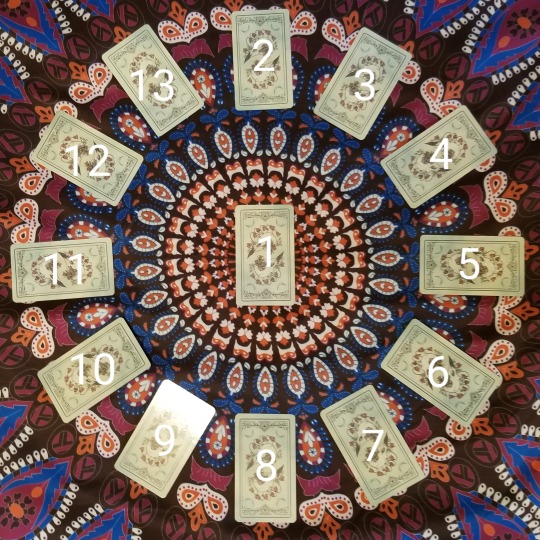
Tarot Spread For The Upcoming Year, Two Ways
First, a simple overview, shown above. Shuffle while concentrating on the upcoming year. If you have a particular type of concern for the days ahead (career, romance, finances, etc), focus on that and ask for guidance. If not, ask for general guidance or predictions and deal as shown. These cards represent:
Overall theme for the year
Message for January
Message for February
Message for March
Message for April
Message for May
Message for June
Message for July
Message for August
Message for September
Message for October
Message for November
Message for December
Read upright/reversed based on their relationship to the center of the wheel; center is the bottom, the rim is the top, so, for instance, card 2 is in a normal orientation, while 5 is on its side with the top to the right.
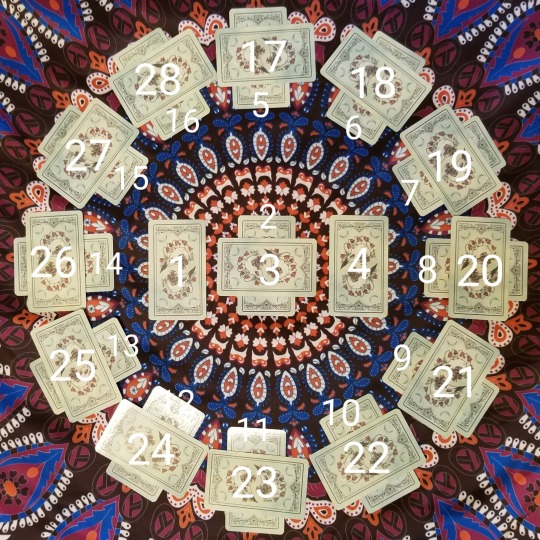
Alternately, you can take a more comprehensive look at the upcoming year. As above, shuffle and concentrate on the kind of overview that would fill your needs. Last the cards as shown. These cards represent:
A lesson you will bring with your from the past year into the upcoming year (will help you deal with the coming year)
Overall theme for the new year
Overall struggle/adversary for the new year
A lesson you will need to learn in the coming year to prepare your for the following year
Message for January
Message for February
Message for March
Message for April
Message for May
Message for June
Message for July
Message for August
Message for September
Message for October
Message for November
Message for December
Struggle/adversary for January
Struggle/adversary for February
Struggle/adversary for March
Struggle/adversary for April
Struggle/adversary for May
Struggle/adversary for June
Struggle/adversary for July
Struggle/adversary for August
Struggle/adversary for September
Struggle/adversary for October
Struggle/adversary for November
Struggle/adversary for December
Read upright/reversed on the monthly messages as indicated with the first spread. The struggle/adversary cards (3 and 17-28) should be read holistically; the upright or reversed meanings may be most appropriate to be aware of. Use your intuition. Be aware that these cards often have advice for how to deal with that struggle.
The struggle/adversary may be a person, situation, mindset, etc.
I suggest reading each month as a pair (its message and struggle/adversary together). You may find that a month that has a negative message may carry advice on the struggle for how to get through it, for instance. It is surprising how these cards interact sometimes.
4K notes
·
View notes
Text
I miss the old eCauldron religion of FlameKeeping.
I also miss the FlameKeeping necklace I had and wore through most of my first attempt at college (lost it in a move).
I think all the time about how it rightfully identified the religious gaps in a lot of pagan paths and offered a really elegant supplement. I come back to it's ideas over and over even as I've invested in other religious paths.
52 notes
·
View notes
Photo
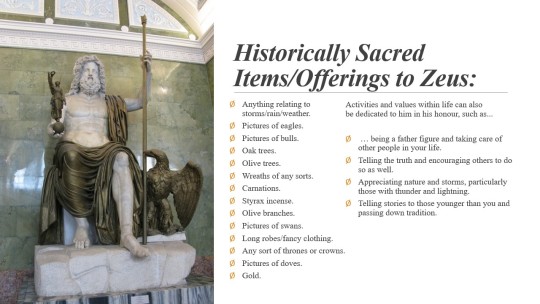
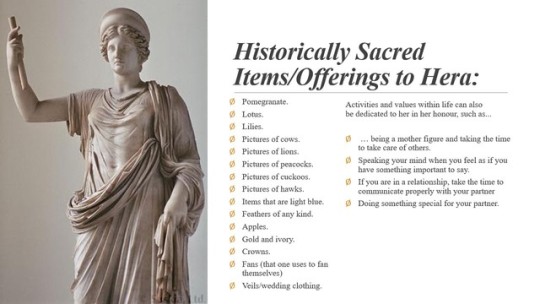


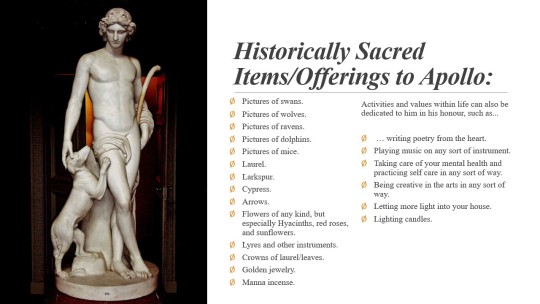


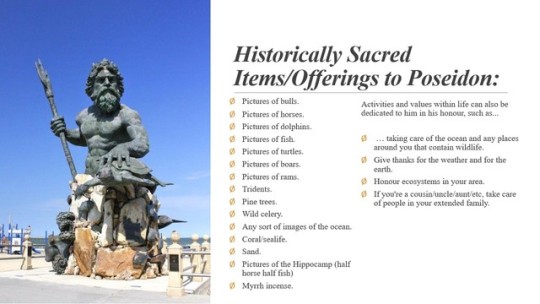
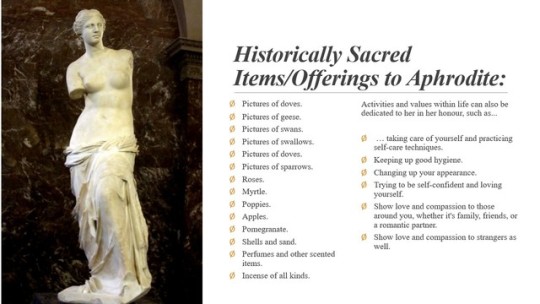


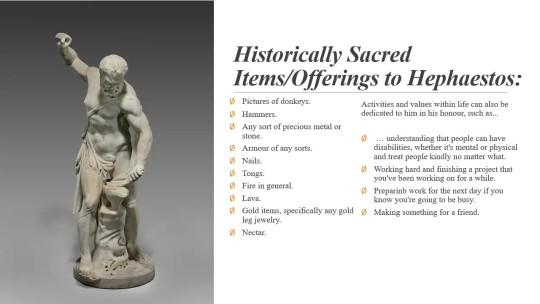
Historically Sacred Items/Offerings to each of the Ouranic Theoi! I made this for my Hellenic polytheism group on discord, so I thought I’d share this information with all of you as well.
All information has been taken from theoi.com as well as various historical books on the gods, and I have decided to make this powerpoint so that other people don’t have to sift through all the pdfs and books themselves.
Make sure to click each image to get a fullview! Ευχαριστώ!
16K notes
·
View notes
Text
when it comes to rituals/offerings/festivals/prayer/etc. i just want to say
late is always better than never, and something is always better than nothing
a day or two late for a festival in your calendar? that’s fine! celebrate it any way!
only have time to light a tea light candle? then light it! even if you only have time to say a short prayer, that’s fine!
if all you have is a small cup of water to offer, then have a quick drink with your gods, ancestors, and other spirits in your life and practice.
as long as you are genuine, your efforts will be appreciated.
307 notes
·
View notes
Text

Looking forward to longer days, but enjoying these beautiful nights. Happy solstice!
8K notes
·
View notes